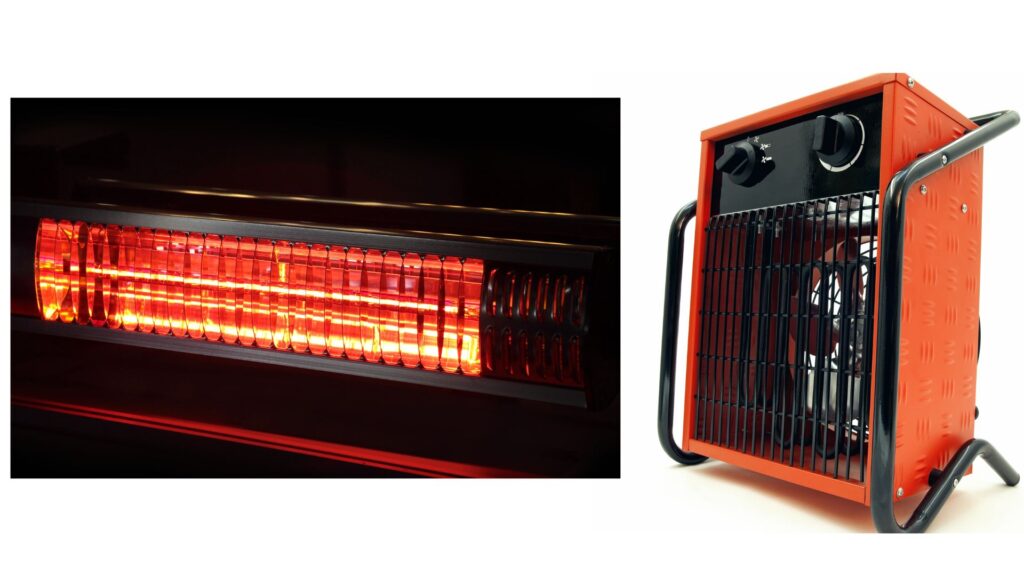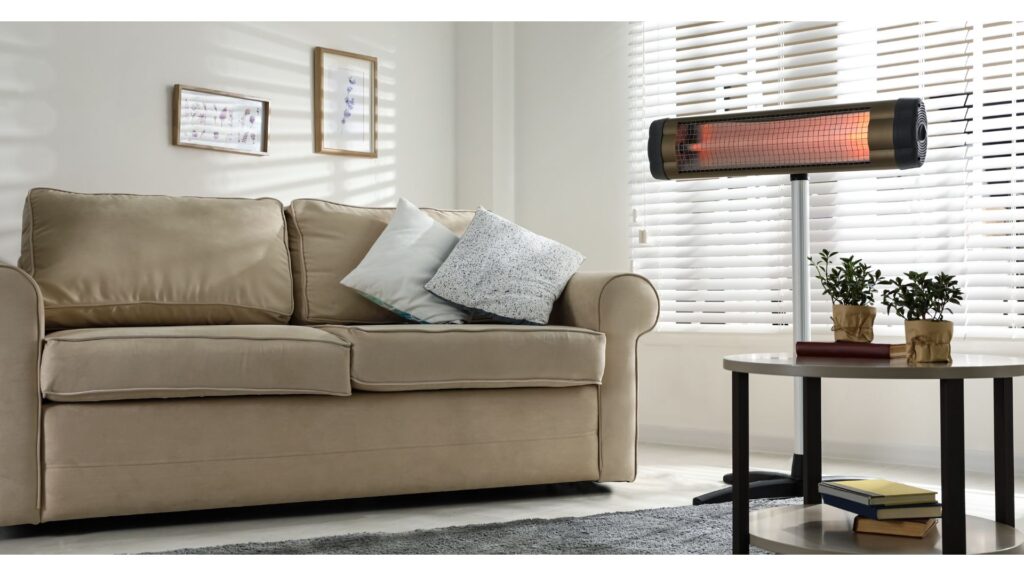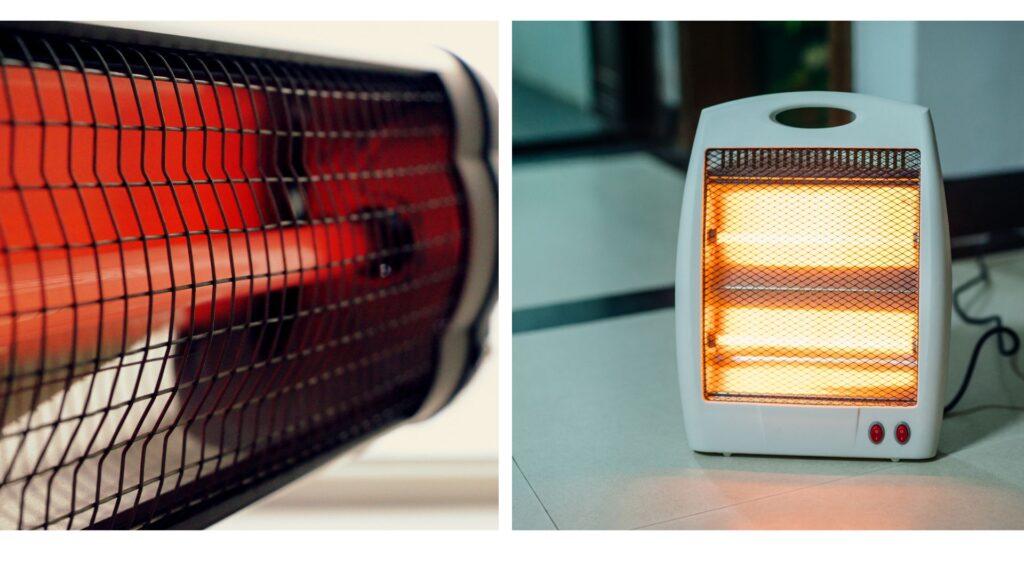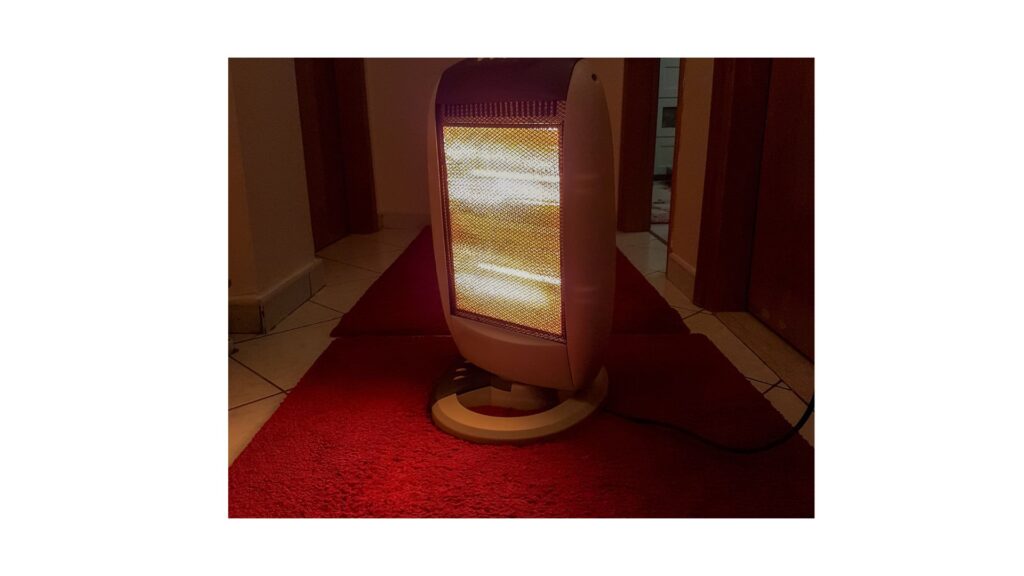Using an infrared heater lowers your electricity bill. When it comes to creating the same quantity of heat in a room, infrared heaters are around 60% more efficient than convection heaters. When compared to the power consumption of a convectional heater with 1200 Watts, the power consumption of an infrared heater with only 300 Watts is only 40% of that. What this means is that your electricity bill will be lower by about 40% .
If you want to properly budget for your infrared heater, you need to know how much power it consumes. One may easily predict their monthly energy cost if they keep track of how much power is consumed. If the heater is utilized for business purposes, knowing how much power it consumes can allow for more accurate budgeting and accounting.
It is important to keep in mind that the infrared energy consumption rating determines both the amount of power utilized and the cost of that electricity.
Does an infrared heater use a lot of electricity?
No. they use less electricity than convection room heaters. Infrared light is the same type of light released by infrared heaters that warms your skin when you stand in the sun or place your hands over a flame. A collection of coils and a reflector are used in infrared heaters to direct the light directly onto the people and objects in a room, rather than the air.
How much does it cost to run a 1500 watt infrared heater for 24 hours?

The cost will be 5.55 dollars using the nationwide average price of electricity in United States. The average retail price of electricity in the United States as at the time of writing (June, 2022) is 15.42 cents per kilowatt-hour given by the US Energy Information Administration . Note that it is either higher or lower depending on the location you live.
The calculation of cost to run a 1500 watt infrared heater for 24 hours goes thus;
1500watts = 1.5kilowatt
24hours x 1.5kilowatt = 36 kilowatt-hours
15.42 cents per kilowatt-hour x 36 = 555.12 cents
Dollar amount = 555.12 / 100 = 5.5512 dollars.
With this, you know how much it cost to run a infrared heater. you also know what your infrared electricity bill will amount to at the end of the month using the number of hours spent in a month.
So the infrared electric heater actually saves you money on your electric bill. You do not waste electricity like the space heaters do. It turns on immediately not like space heaters that need some time to heat every part of the room. You only put your infrared heater whenever you need it and put it off when you don’t.
What are the disadvantages of infrared heating?
In spite of it’s efficiency at heating in the house, the infrared electric heater still has some disadvantages.
- There is a possibility that an infrared heater will not be able to produce sufficient heat in a space that is very large.
- As soon as the power is turned off to an infrared heater, that device’s capacity to produce heat is immediately terminated.
- Only the area directly in line of sight of the heater will be heated by an infrared heater.
- When turned up to their maximum power settings, infrared electric heaters are capable of producing a significant amount of heat. Be careful if you have kids or dogs who are easily curious.
- trying to find the perfect temperature for the space might be challenging because an infrared electric heater often only has two or three power settings to choose from.
Which is cheaper to run: a ceramic or an infrared heater?
Infrared heaters are more efficient to run, therefore cheaper. While the price of electricity, the power consumption of the heater and the number of hours run are the three determinants of your electricity bill, the fact that the infrared heater heats instantaneously reduces the hours run which in turn makes it cheaper than ceramic heater.
The infrared heater therefore uses less electricity than the ceramic heater and is better.
Are infrared heaters cheaper than central heat ?
Yes infrared heaters are cheaper than using a centralize heating system. The infrared heaters use electricity while gas is used for central heating system. And you and I know that electricity is costlier than gas. So how come it is cheaper to use infrared heaters. Let’s take a look.
The U.S. Energy Information Administration (EIA) reported that the average electric bill for U.S. households came in at $117.46 per month in 2020, and the American Gas Association said in a 2020 report that households in the United States spent an annual average of $667 in natural gas to heat and fuel their homes. That comes out to a bit more than $55 a month. Historically, electricity has always been more costly than gas.
However. Because you can select the rooms you want to heat and switch on the panel heater just in those areas, infrared heating is an exceptionally energy-efficient method of warming a home. This method, also known as zone heating, entails applying heat to certain regions of your house on demand, as and when it is necessary to do so.
Also, because infrared heating can be adjusted to any temperature at any time in any part of your home, zone heating is an extremely effective method for lowering your total heating expenditures. This is made possible by the fact that infrared heating may be used in any area of your home. Not like with gas, where you often only have one tank for the entire house.
This indicates that operational expenditures are greatly decreased when compared to other means of home heating, notably gas, which must be turned on for an extended length of time before you feel full warmth throughout your house.
When compared to traditional electric heating systems, infrared heating panels use a significantly lower amount of power, and as a result, have a lower cost to operate on an hourly basis.
Can you leave infrared heaters on all night?
An infrared heater is safe to leave on all night. When the system detects that the temperature has reached an unsafe level, it will turn off by itself. In the case that the heater is knocked over, a built-in safety device will turn it off to prevent any potential fire incident. Nevertheless, you shouldn’t take the chance of leaving any an infrared heater on while you sleep or while you’re out of the.
An infrared heater that has safety measures such as a thermostat, a timer, and auto-shutoff in case it gets too hot, is the type recommended to leave it on throughout the night.
Where should I place my infrared heater?
The best location for an infrared heater in a room is the wall in your room that is facing most objects or persons in the room. The infrared heater works by transmitting heat directly to object in it’s path or line of sight. So for it to heat as many objects ( or persons ) as possible, in a room, it must be placed where it has maximum line of sight view to most objects in a room. This location is on a wall.
The second best location for placing an infrared heater is on the ceiling. Though we have to bear in mind that there maybe fittings that will obstruct this line of sight of the infrared heater.
What are the pros and cons of infrared heater?
In order to have a good grasp of a electric infrared heater lets look at it’s advantages and disadvantages.
Pros.
1. It is more efficient compared to convection heaters.
2. It starts to heat immediately after it is switched on.
3. It does not dry the air like convection heaters do.
4. Simple to install and maintain
5. It’s portable and doesn’t take up much space.
6.They are quiet in operation.
7. Does not pollute the air in the room
8. Save on heating by warming specific zones in the house instead of the whole house.
Cons.
1. the heated coils of an infrared heater could get very hot thereby constituting a tential injury source for kids and pets.
2. The heat is lost once the infrared heater is turned on. You don’t get this residual heat that the space heaters leave even after they are switched off.
3. Using infrared for long periods of time could cause skin problems.
4. Because of the targeted heating that infrared heaters provide. You don’t get to enjoy the warmth when you move away from the zone that is being heated. So, if you move from one room to another, you could be moving from a heated area to a cold area until you come back to the heating zone.
5. there is this orange color that the infrared heater gives of which is supposed to discourage someone from touching it. Well, this bright light might be an irritation when you want to sleep. so using it in the bedroom may not be ideal.
Are infrared heaters good for large rooms ?
Yes they are good for large rooms. An 8 element infrared heater would adequately heat a large room. Having more elements gives it more heating surface area to dissipate heat, which allows it to pull more power all the time. A 1500watts infrared heater that actually draws 1500 watts and can dissipate heat continuously on a high setting will heat a large room well.
It is not necessary to point it directly at the place where you will be sitting. Some of these infrared heaters are designed to also circulate the air in the expansive area, which helps to gradually raise the temperature within the space. You don’t need to be concerned about getting a sunburn by standing in front of one of these heaters for a lengthy period of time because there is such a small amount of airflow coming from it.
Which is better infrared or quartz heater?
There is very little difference between a infrared and a quartz infrared heater. As is the case with most other kinds of heaters, the usage of electricity powers the heating element in a quartz infrared heater. Any area of your body that is situated in a position where it is going to be in direct contact with the radiated heat that is being emitted by the heater will experience a sensation of warmth. Quartz is used for the component that is responsible for the heating.
The infrared heater’s heating material is a coil of wire such as carbon wires.
This is the main difference between the quartz infrared and the infrared heaters.
Are infrared heaters good for bedrooms?
Bedrooms are the perfect location for using infrared heaters. They can be set to work all through the night or run in certain parts of the night at desired temperature without the need to get up and monitor them.
Due to the nature of infrared, installing it in your infrared bedroom heaters will give you complete silence, won’t disrupt dust or other allergens, and there will be no stuffiness or dryness. Putting your infrared heater in your bedroom keeps your bedroom warm and cozy without any of the drawbacks of conventional heating systems.
In contrast to convection heat, infrared heat is focussed and will start to warm you up almost as soon as it is applied. As a consequence of this, you may be able to achieve the heating capacity of a space in a more effective manner.
Traditional heaters are bulkier and more cumbersome than their infrared counterparts; however, infrared heaters may be installed on the wall and are much smaller.
It is perfect for drafty bedrooms or rooms with inadequate insulation because the heat it generates is unaffected by open windows or drafts.
Which is better: an infrared or a fan heater?

The infrared heater is better and more efficient than the convection fan heaters. For the same power rating and number of hours run the infrared heater will heat a room faster and more effectively than the fan heater. While the fan heater will take some time to warm the air the infrared heater that heat by direct radiation of heat to intended objects will heat faster. Since the infrared heater does not heat the air in the room, it’s radiated heat is not subject to disruption by draught from an open window unlike the fan heater. The infrared heater is also noiseless unlike the fan heater whose noise can be very irritating to some users.
Is infrared heating the future?
When it comes to heating with electricity, infrared technology is the direction in which things are heading. It is a cutting-edge solution that is also kind to the environment, and it can be used to remain warm in either the house or the office.
Traditional heating techniques that rely on fossil fuels are being phased out in favor of infrared heating systems in buildings of all types, including residential and commercial properties.
For a variety of reasons, infrared heating has become increasingly popular in recent years.
- Infrared heating has been shown to be effective for a wide range of health disorders by a number of studies, and as a result, it is now often employed in the treatment of rheumatism and physiotherapy. When used, it strengthens the immune system, relieves hurting joints, and causes the heart to pump more blood throughout the body. As a result, the use of infrared heating contributes to a more expedient recovery from injuries.
- Because infrared heating causes less air movement throughout the room, there is a corresponding reduction in the amount of allergens and dust that are spread throughout. Because it helps to alleviate the effects of asthma and allergies, the heating system is perfect for anyone who suffer from either of those conditions.
- Due to the fact that the panels rely just on electricity, they are installed without the need for a boiler or any additional piping. This type of heating is not only easier and more cost-effective than the traditional wet central heating systems, but it also has more immediate benefits. These benefits include the ability to precisely regulate the temperature of specific rooms to meet the needs of the occupants. In addition, the panels require very little maintenance or repair, if any at all.
More reasons why infrared heating is the heating of the future is that.
If you are looking for a way to heat your home, it is important to keep in mind that just because convection heating is the most common method, this does not necessarily mean that it is the most effective method, especially given the development of alternatives that are more energy efficient, such as infrared heating. In convection heating, the area directly in front of the heater will be warm, but the areas further away will have chilly patches or pockets of cooler air. In addition, convection heaters are known for squandering energy due to the fact that heated air rises, which results in a significant temperature difference between the lower and top levels of the room.
Infrared (IR) panels, on the other hand, make use of electromagnetic waves to stimulate molecules within an object or a person, which ultimately results in the object’s or person’s own mass creating heat as opposed to more typical heating methods. It performs a role that is analogous to the way in which the sun heats the earth each day.
How long does it take for an infrared heater to heat a room?

For an averaged size room, it takes about 5 to 10 minutes to heat the whole room depending on where the infrared heating panel is positioned. For a much larger room, the heating time will depend on certain things.
- The insulation of the room
- The ambient temperature of the room
- Humidity levels
- The number of objects in the room
- The power wattage of the infrared heater.
So depending these variables which are different for different people, heating a large room could take between 30 minutes to 1 hour.
Can infrared heaters catch fire?
No infrared heaters do not cause fires. That is when used in the correct way. These heaters come with protective features such as
- Over heat protection
- Tip over protector
- Protective casing for hotness.
However, you need to take some precautions when using an infrared heater.
- Make you do not buy a cheap infrared heater with parts that might not withstand high temperatures.
- Also make sure you do not plug an infrared heater into an extension box because this could heat up the cable of the extension box, melt it and catch fire.
Can infrared heaters be placed on carpet?
Yes definitely. Modern infrared heaters can be placed on carpets. These are built to protect any surround objects from the internal heat of the infrared heater. These heaters are built with surrounding casings that are cool to the touch and safe for children and pets. So they are not hot to the touch. Some come with glide casters at the bottom of the heaters that also allow you to move the unit from room to room.
How many infrared heaters do I need?
One infrared heater for each room. If the room is large, get one with high wattage ( typically 1500 watts ) and install in a strategic location in the room so that most objects are within sight and range of the infrared heater. If installing in an L shape room, you may need more than one infrared heater to heat the room.
Keep in mind that the panel only warms the object directly in front of it.
It will eventually heat an entire room, but anything that is not directly in line with the panels will take far longer to warm up.
For very large rooms or L-shaped rooms, heater panels could be arranged in the center of the room or kept at similar distances from one another, so that the heat that they emit will be more uniform.
How far away do infrared heaters work?
1000 sq ft of heating coverage. This distance depends on the power and type of infrared heater. If the heater comes with a blower, then it can deliver its power at a farther distance than one without.

Author: Saleh Ibrahim







